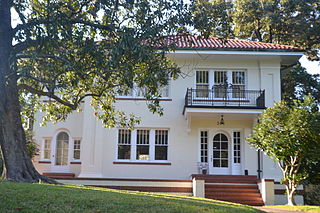
The Louisiana State Capitol is the seat of government for the U.S. state of Louisiana and is located in downtown Baton Rouge. The capitol houses the chambers for the Louisiana State Legislature, made up of the House of Representatives and the Senate, as well as the office of the Governor of Louisiana. At 450 feet (137 m) tall and with 34 stories, it is the tallest skyscraper in Baton Rouge, the seventh tallest building in Louisiana, and tallest capitol in the United States. It is located on a 27-acre (110,000 m2) tract, which includes the capitol gardens. The Louisiana State Capitol is often thought of as "Huey Long's monument" due to the influence of the former Governor and U.S. Senator in getting the capitol built. The building's construction was completed in 1931. It was listed on the National Register of Historic Places in 1978 and was designated a National Historic Landmark in 1982.

Beauregard Town, also known as Beauregard Town Historic District, is a historic district in downtown Baton Rouge, Louisiana, anchored by Government Street. It was commissioned in 1806 by Elias Beauregard, and was listed on the National Register of Historic Places in 1980. It is the second-oldest neighborhood in Baton Rouge.

Theodore C. Link, FAIA, was a German-born American architect and newspaper publisher. He designed buildings for the 1904 World's Fair, Louisiana State University, and the Mississippi State Capitol.

The Old Louisiana State Capitol, also known as the State House, is a historic government building, and now a museum, at 100 North Boulevard in Baton Rouge, Louisiana, U.S. It housed the Louisiana State Legislature from the mid-19th century until the current capitol tower building was constructed from 1929-32.

The Pentagon Barracks, also known as the Old United States Barracks, is a complex of buildings located at the corner of State Capitol Drive and River Road in Baton Rouge, Louisiana, in the grounds of the state capitol. The site was used by the Spanish, French, British, Confederate States Army, and United States Army and was part of the short-lived Republic of West Florida. During its use as a military post the site has been visited by such notable figures as Zachary Taylor, Lafayette, Robert E. Lee, George Custer, Jefferson Davis, and Abraham Lincoln.

The Old Louisiana Governor's Mansion is located at 502 North Blvd. between Royal and St. Charles Streets in Baton Rouge and was used as Louisiana's official gubernatorial residence between 1930 and 1963; a new residence was completed in 1963. The Old Governor's Mansion was built under the governorship of Huey Long, its first resident. The building is reported to be inspired by the White House in Washington D.C. as it was originally designed by Thomas Jefferson. It is said that Long wanted to be familiar with the White House when he became president, so he had the White House duplicated in Baton Rouge. Some dispute this legend and simply say that the building is merely a fine example of a Georgian-style mansion.
City Park Golf Course is a public golf course in Baton Rouge, Louisiana, and was the first public golf course and the city's only public course until the mid-1950s. The short, 34-par, nine-hole course was completed in 1926 and officially opened in 1928.

Magnolia Cemetery is a 10-acre (4.0 ha) cemetery in Baton Rouge, Louisiana.
Leland College was founded in 1870 as a college for blacks in New Orleans, Louisiana, but was open to all races. After its original buildings burned in 1923, it was relocated near Baker, Louisiana. Never accredited, the school closed in 1960 because of financial difficulties.

This is a list of the National Register of Historic Places listings in East Baton Rouge Parish, Louisiana.

The Huey P. Long House on Forest Avenue in Shreveport, Louisiana was built in 1926. It was listed on the National Register of Historic Places (NRHP) in 1991.

Longwood is a plantation located at 15417 River Road in East Baton Rouge Parish, Louisiana, which was listed on National Register of Historic Places in 1983. Directly across the street is a levee holding back the Mississippi River.

Mount Hope Plantation House is a historic plantation house located at 8151 Highland Road in Baton Rouge, Louisiana.

St. Elizabeth of Hungary Catholic Church is a historic Roman Catholic church is located at 114 Louisiana Highway 403 in Paincourtville, Louisiana, in Assumption Parish. In 2000 the ecclesiastical parish of St. Elizabeth was clustered with St. Jules in Bell Rose, also in the Diocese of Baton Rouge.

The Audubon Plantation is a Southern plantation with a historic mansion located at 21371 Hoo Shoo Too Road, Baton Rouge, Louisiana.

The Reiley-Reeves House is a historic house located in the Garden District of Baton Rouge, Louisiana, at 810 Park Avenue.

The Baton Rouge City Club, also known as the Old Post Office, is a historic three-story building at 355 North Blvd in Baton Rouge, Louisiana. It was built in 1895 as a U.S. post office building.
Paul Narcisse Cyr DDS, nicknamed the "Wild Bull of Jeanerette", was an American politician, dentist, banker, and geologist, who served as Lieutenant Governor of Louisiana from 1928 to 1931, unsuccessfully declared himself Governor of Louisiana, and was first an ally and then an opponent of Governor Huey Long.


















